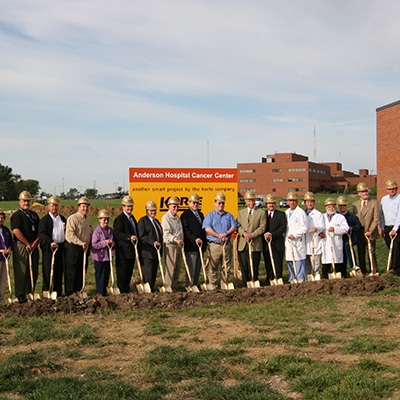Maintaining access to quality healthcare is a concern among urban, suburban and rural communities alike. And while stakeholders everywhere likely agree that building modern, responsive facilities can enhance access to quality care, many Critical Access Hospitals, rural healthcare clinics and ambulatory care facilities struggle to secure the capital required to complete construction, renovation or expansion projects.
How can a Design-Build firm assist these important hospital and healthcare organizations’ access to capital? After all, we’re not a financial services company.
But we are design and construction experts with decades of experience building healthcare facilities in rural areas. And over the last six decades working with these critical healthcare providers, we’ve developed processes and expertise that guide healthcare organizations toward financing opportunities and help maximize funding without jeopardizing future operations.

I need to build—but can I afford it?
It’s the unenviable task of rural hospital boards and their administrators to ensure their hospital facilities can provide high quality, affordable care even as local code compliance, economic and health policy conditions make it increasingly difficult to do.
Maybe you believe construction is the best way to meet patients’ needs, but you’re not yet comfortable with the prospect of planning, phasing and constructing a modern healthcare facility.
To start, you must know precisely what you need. This is difficult to pinpoint because healthcare boards and administrators aren’t always aware of the building code issues that will impact planning and add unknown costs. For instance, if you renovate one room, will it force you to upgrade the entire floor to meet updated codes? A Healthcare Design-Builder can not only tell you the answer, they can accurately project the cost and suggest other options for solving the problem.
A knowledgeable Design-Builder can help your hospital define the program elements (how much of what, how big and how many) that you need and as a Design–Builder they can discuss costs and options throughout the process.
The National Rural Health Resource Center’s Capital Project Readiness Guide offers self-assessment tools that a knowledgeable Design–Builder can help your hospital stakeholders interpret as construction plans, programs and budgets are developed. When stakeholders work through these assessments with an experienced healthcare builder, they can avoid the expense and hassle of hiring multiple consultants whose individual recommendations must be reconciled.
The American Hospital Association’s Guide to Financing Strategies can be utilized to inform rural hospital boards and administrators about the general financial challenges smaller organizations face. The AHA guide doesn’t specifically address construction, but the strategies it addresses should help you as you develop the financing program best suited to support a future project.
Alternative financing sources
What about actually accessing the funds needed to complete a project? Completing the checklists, securing approvals and sketching initial designs is one thing, but having the dollars in hand to begin construction is quite another.
Access to capital is often the reason that unaffiliated Critical Access Hospitals decide to merge with—or be acquired by—larger hospital systems. These organizations usually don’t have adequate cash reserves and often lack the bond rating required to secure financing under conventional terms. It doesn’t help that the reimbursement payments to hospitals for expenses covered by Medicare and Medicaid are seldom made promptly and almost never in full.
Facilities serving economically depressed populations rely more heavily on these safety net reimbursements and less on payments from private insurers, severely limiting their ability to initiate projects that improve patient care and create an environment where skilled doctors want to work.
Common healthcare construction financing options
One common method of financing construction in these situations is to secure funding from the U.S. Department of Agriculture’s Community Facilities Program. The Korte Company employs a team of experts who help organizations navigate this process. We can evaluate the condition of an existing hospital, recommend infrastructure upgrades or replacement (whichever is more cost effective) and, as both a designer and builder, we can accurately project the cost of these options.
Publicly owned hospitals have the option of requesting taxpayer assistance to fund capital projects. It might not be ideal to add to local tax burdens (in the form of property tax or sales tax increases, or via other special assessments), but many financially struggling small hospitals have won community support by clearly expressing their needs.
U.S. Department of Housing and Urban Development Section 242 financing is also available for acute care hospitals, though in our experience the HUD financing process is much more complex and is geared toward larger cities. Most times, USDA is the better bet for rural hospitals.
These are only a few of the financing methods available. The Korte Company is well versed in other mechanisms that have been utilized.
The healthcare construction team at the Korte Company includes a Board–Certified Hospital Administrator / Executive who has consulted on more than 40 USDA Design–Build funded projects. Having an experienced hospital administrator on the Design-Build team helps stakeholders overcome the most difficult construction planning challenges. That means community healthcare providers can deliver fiscally resilient spaces that truly meet present and future community needs.
But back to the question at the beginning of this section. Can my hospital afford it?
Hopefully, with the help of the resources above, your planning team can conclude not only whether you can afford to build, but roughly how much you can spend and where the funds will come from. You may find that knowledgeable hospital and healthcare Design–Builders will provide you much of the assistance outlined above without ringing the cash register at all.
Now you’re ready to approach a Design-Build company. We think The Korte Company is perfect for the job.
Why Design-Build for rural healthcare construction?
It’s about extracting the absolute most value possible from a finite resource.
Design-Build construction emerged from the belief that thinking differently about how projects are planned and executed would result in customers getting more for their investment.
Consider these healthcare Design-Build characteristics:
First, a single point of contact keeps all stakeholders on the same page, reduces delays and aids in the speedier resolution of conflicts.
Second, design teams apply their healthcare operational experience to develop efficient and effective hospital program plans that account for user flows and make life easier for doctors, nurses, staff, visitors and—most importantly—patients. What’s more, the combination of both design and construction expertise in one organization means material or system innovations can be utilized that result in lower costs and more value over time.
Third, construction management teams are experts in creative phasing of projects to maximize available resources, accelerate timelines to save on labor costs and minimize disruption to adjacent activity. That’s especially critical in healthcare renovation or expansion projects.
Those are just a few reasons why Design-Build is perfect for rural hospital or clinic construction projects. Learn more here.
If you want to see proof that healthcare Design–Build organizations can build modern facilities that meet their patients’ evolving needs, review these rural healthcare projects:
Utah Navajo Health System – Blanding Family Practice – Completed in 2019, this 42,167-square-foot facility combines medical, dental and optometry care under one roof for underserved communities in Utah’s southern desert.
Plains Memorial Hospital – The 45,234-square-foot senior living facility we built represents a critical expansion of services provided by this organization, which was originally founded in Dimmitt, Texas in the depths of the Great Depression.
U.S. Army McAfee Health Clinic – This 35,735-square-foot full-service clinic serves soldiers stationed at the White Sands Missile Range in southeastern New Mexico. Its current design purposely anticipates future expansions to both wings of the structure. This project is just one of quite a few healthcare projects we’ve delivered over the span of our construction relationship with the U.S. military.
Anderson Hospital – Goshen Medical Office Campus – The 18,331-square-foot ambulatory surgery center and clinic currently under construction is the first of several planned structures on a ten-acre site serving patients in suburban and rural southwestern Illinois.
Harrisburg Medical Center – Our 28,000-square-foot addition and renovation of this rural hospital in southern Illinois consisted of a new, two-story partial atrium, a new operating room, a new cardio-pulmonary gym, an expanded surgical suite, the relocation of a helipad and an improved lobby and gift shop.
Fayette County Hospital – The expansion of this Critical Access Hospital in Vandalia, Illinois totaled 11,655 square feet and featured a new drop-off canopy, a new lobby, a new lab, shell space for a future MRI lab, a new gift shop and expanded administrative space.
The bottom line
When hospital organizations confront fiscal realities that could challenge the success of planning future construction projects, the bottom line is this: Design-Build firms with rural hospital healthcare construction experience are ideal partners. They know how to navigate tricky fiscal conditions and are experts at identifying opportunities to innovate that lie just beyond financial barriers.
If you’re interested in getting a Design-Builder’s perspective on the opportunities your potential project presents, contact us now.
